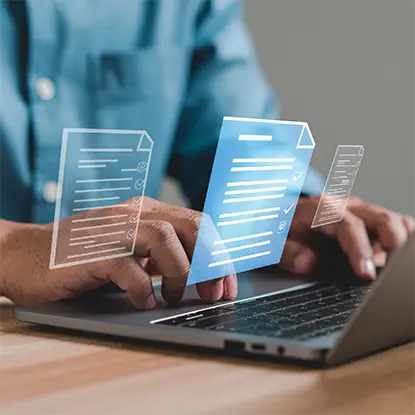Cognitive Capture:
How AI Goes Beyond Traditional OCR


Published: November 05, 2025
In the world of enterprise automation, data is the new oil - but like crude oil, it’s useless until refined. For decades, Optical Character Recognition (OCR) has been the standard method for converting documents into digital text. Yet, traditional OCR can only see characters; it cannot understand them.
Now, artificial intelligence (AI) has transformed this capability into something far more powerful: Cognitive Capture - a next-generation approach that doesn’t just extract text, but comprehends context, intent, and meaning. It’s the difference between reading a word and understanding a sentence.

Go beyond legacy OCR with docAlpha’s intelligent process automation platform. Capture, classify, and extract data from any document, with unmatched accuracy.
Traditional OCR was designed to solve one problem - converting images of text into machine-readable format. This technology, though revolutionary in the 1980s, is inherently limited. It works best with structured documents and high-quality scans. If a form is skewed, handwriting is unclear, or the layout changes slightly, OCR accuracy drops dramatically.
Cognitive Capture represents the next leap. By integrating AI, machine learning (ML), and natural language processing (NLP), it can interpret not only what the text says but also what it means. It understands invoices, contracts, emails, and unstructured documents the way humans do - through context and reasoning.
Dr. Ananya Deshmukh, an AI automation scientist at Artsyl Technologies, summarizes this shift:
“OCR extracts information. Cognitive Capture interprets information. That’s the defining difference - one sees pixels, the other perceives intent.”
Recommended reading: Document Capture Technology: Best Tips and Tricks
Cognitive Capture combines multiple layers of intelligent processing to achieve human-like document understanding. Let’s break it down.
AI models are trained on thousands of document types, learning to recognize variations in layout, field positions, and font types. This allows the system to handle unstructured data - such as invoices from different vendors or contracts in multiple formats - with remarkable accuracy.
NLP enables Cognitive Capture systems to interpret semantics and relationships between words. For example, it can tell the difference between “invoice number” and “total due,” even when formatting varies. It also understands synonyms, abbreviations, and linguistic nuances.
AI-Driven Accuracy For Invoice Processing
Capture, validate, and post invoice data into your ERP - fast and error-free. InvoiceAction applies AI to extract invoice data with full context and control.
Book a demo now
Modern Cognitive Capture engines use computer vision algorithms to recognize logos, stamps, signatures, and checkboxes. This visual layer adds context, improving classification accuracy and fraud detection.
Advanced platforms like Artsyl’s docAlpha employ AI-driven knowledge graphs that connect extracted data points. This helps validate information - for instance, confirming that a vendor name matches an authorized supplier in a company’s ERP system.
Together, these capabilities enable end-to-end automation: documents are not just digitized, but understood, categorized, and routed automatically - without human intervention.
Recommended reading: What Is Data Capture? The complete guide
OCR focuses purely on converting image-based text into characters. It doesn’t know whether “10/03/25” is a date, an ID, or a code. It simply passes the string along, leaving humans to interpret it.
Invoices, receipts, and contracts often vary in structure. OCR requires templates or zoning, which means it fails when a document’s layout changes.
Traditional OCR doesn’t learn. Every correction must be done manually, and errors persist across batches. Cognitive Capture, however, continuously learns from user corrections, improving accuracy over time.
In short: OCR tells you what’s on the page; Cognitive Capture tells you what’s behind it.
Smart Invoice Capture Start With AI
InvoiceAction transforms messy PDFs into structured, clean data. Cut costs, improve auditability, and increase team capacity.
Book a demo now
Organizations worldwide are adopting Cognitive Capture to automate information-heavy workflows.
Invoices come in all shapes and formats. AI-powered capture systems can identify supplier names, purchase order numbers, and line items - even from handwritten or low-quality PDFs - and feed them directly into ERP systems like SAP or Oracle. This reduces processing time from hours to seconds.
In industries like insurance or healthcare, Cognitive Capture extracts patient data, claim IDs, and policy numbers from complex, multi-page forms while maintaining compliance with privacy regulations (HIPAA, GDPR).
AI reads contracts to detect clauses, renewal dates, and risk factors. It even flags ambiguous language - something that OCR could never do.
Faster document handling leads to quicker responses and happier clients. Automated onboarding, for example, allows banks to verify documents and open accounts within minutes.
According to IDC’s 2024 Intelligent Document Processing Report, companies implementing Cognitive Capture experience an average 35% reduction in manual processing costs and a 50% improvement in data accuracy.
Recommended reading: Invoice Data Capture: Best Practices for Processing
As organizations adopt AI-powered systems, data security and identity management become more critical than ever. Cognitive Capture relies on sensitive document data - from invoices to personal IDs - and must handle this responsibly.
In this evolving digital ecosystem, secure and context-aware tools such as Try Overchat Username Generator play a surprisingly practical role in supporting safe system onboarding. When teams test or integrate Cognitive Capture solutions across multiple environments, generating consistent yet anonymized usernames ensures privacy during machine learning model training.
This approach represents the broader philosophy of cognitive automation: using AI not only for intelligence but also for integrity - ensuring that innovation and ethics move in sync.
Smarter Processing From Input To Insight
Leverage docAlpha to streamline how documents move through your business. AI, ML, and RPA combine to reduce errors and accelerate workflows.
Book a demo now
Let’s break down how Cognitive Capture fundamentally outperforms its predecessor:
| Aspect | Traditional OCR | Cognitive Capture (AI-Powered) |
| Data Type | Structured only | Structured & unstructured |
| Learning Ability | Static templates | Self-learning (AI/ML) |
| Accuracy | 70–80% | 95%+ with feedback loops |
| Context Awareness | None | High — understands meaning |
| Automation Scope | Extraction only | End-to-end workflow integration |
| Error Handling | Manual correction | Continuous improvement |
| Scalability | Limited | Enterprise-wide |
Cognitive Capture doesn’t just make OCR “better” - it replaces the old paradigm with intelligent automation that grows smarter with every document processed.
Recommended reading: Enhancing Data Capture with OCR: Key Techniques and Tools
Cognitive Capture is often seen as the first stage in the broader Intelligent Process Automation (IPA) ecosystem. Once data is extracted and understood, it can be passed to robotic process automation (RPA) bots, analytics engines, or ERP workflows for further action.
For instance:
This seamless handoff between systems forms the backbone of hyperautomation, where manual work is reduced to exception handling only.
As Gartner’s 2025 forecast predicts, over 65% of enterprises will have deployed Cognitive Capture as part of their automation architecture.
Accelerate Sales Order Turnaround With AI
OrderAction reads and processes incoming orders automatically. No more delays from email, fax, or scanned PDFs.
Book a demo now
Despite automation, humans remain central to Cognitive Capture’s success. AI systems still rely on “human-in-the-loop” feedback for continuous learning and quality assurance. When the system encounters ambiguous data, human operators validate it - feeding corrections back into the model. Over time, these models achieve near-human accuracy autonomously.
Dr. Robert Klein, Head of Automation Strategy at IBM, explains:
“Cognitive Capture isn’t about removing people from the process. It’s about elevating them - freeing human workers from repetition so they can focus on reasoning, creativity, and judgment.”
This hybrid collaboration defines the future of intelligent enterprises.
Recommended reading: OCR Data Capture with Artificial Intelligence
While Cognitive Capture offers significant advantages, it also poses challenges that require responsible management:
Ethical AI frameworks are emerging to govern how Cognitive Capture systems handle sensitive information - emphasizing fairness, accountability, and transparency.
Transform Documents Into Decisions
docAlpha goes beyond OCR by applying AI to every data point. Gain insights faster with fewer human touchpoints.
Book a demo now
Cognitive Capture is still evolving. The next generation will combine generative AI with knowledge-driven reasoning, enabling systems to summarize documents, answer questions, and even predict workflow bottlenecks.
Soon, document processing systems will converse with users in natural language:
“Do you want me to reconcile these invoices?”
“Should I flag this clause as a compliance risk?”
The future of automation will not just be faster - it will be conversational, contextual, and collaborative.
Recommended reading: OCR Capture vs. Artificial Intelligence: Unraveling the Advancements in Document Processing
In conclusion, Cognitive Capture represents the true evolution of document automation. By combining perception, context, and reasoning, it moves beyond the limits of OCR - transforming static data into dynamic business intelligence.
As enterprises embrace this technology, they’re not just digitizing information; they’re building systems that think, learn, and collaborate - ushering in the era of intelligent automation where data truly drives decision-making.